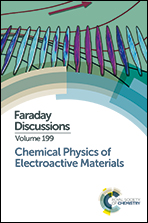Energy harvesting from aperiodic low-frequency motion using reverse electrowetting
Abstract
Mechanical energy harvesting can provide a promising alternative to electrochemical batteries, which are currently widely utilized to power mobile electronics. In this work we present a theoretical analysis of a recently proposed method of mechanical energy harvesting, which combines a reverse electrowetting phenomenon with the fast self-oscillating process of bubble growth and collapse. We investigate the details of the bubble dynamics and analyze the dependence of the energy generation process on the system parameters. The results demonstrate that self-oscillation frequencies of several kHz are possible, which can lead to very high power generation densities in excess of 104 W m−2. The obtained results indicate the possibility of high-power energy harvesting from mechanical energy sources with very low frequencies, well below 1 Hz.
- This article is part of the themed collection: Chemical Physics of Electroactive Materials

 Please wait while we load your content...
Please wait while we load your content...